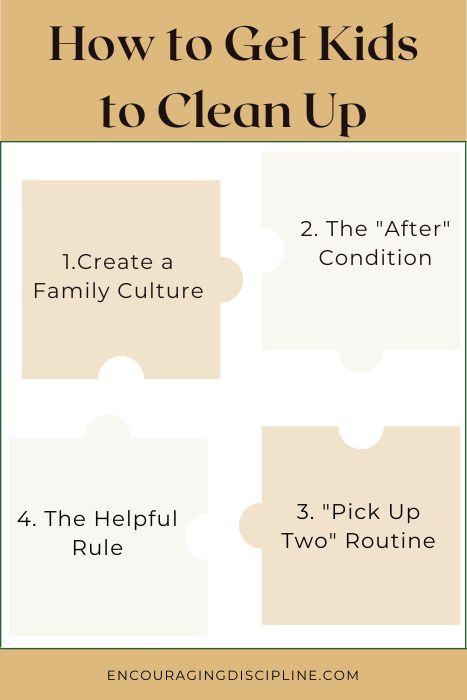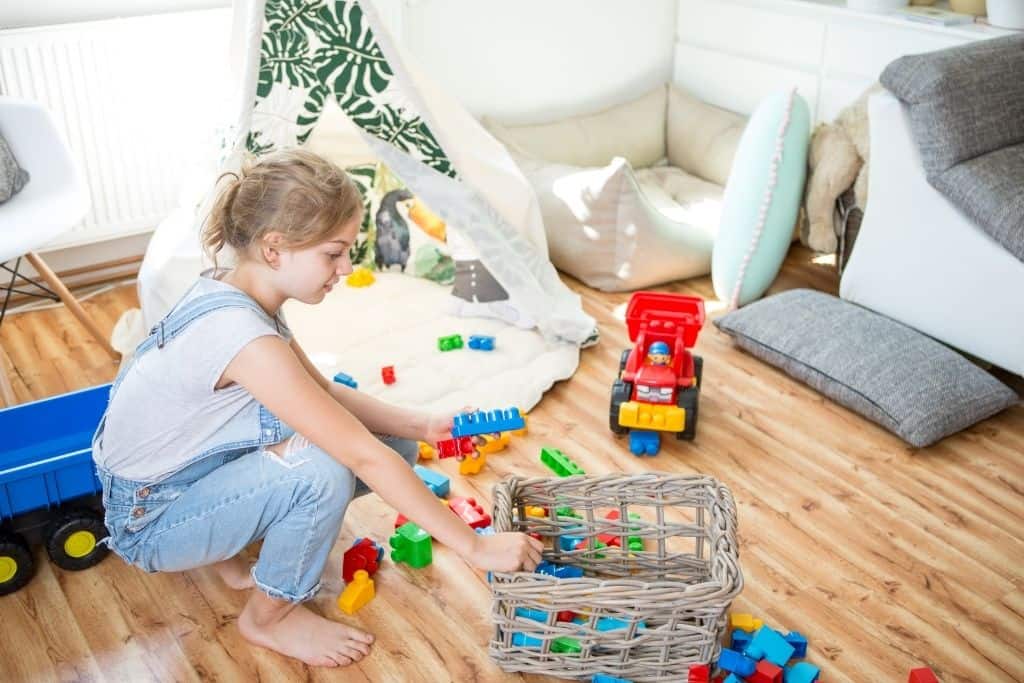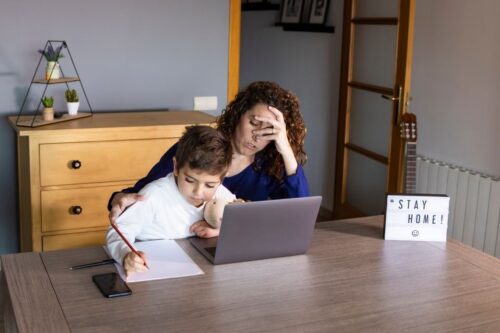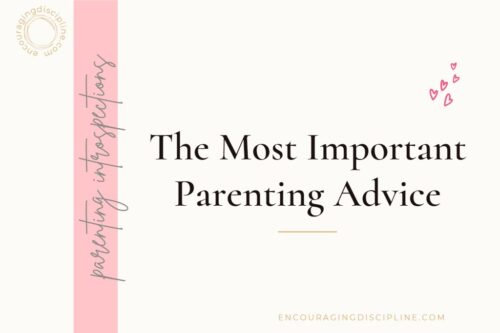How I Get My Kids to Clean Up Consistently
Are you struggling to get your kids to clean up? Do they whine, complain, or flat-out refuse to pick up their toys, books, clothes, or craft supplies? Does your house look like a bunch of savage toddlers threw a party in a toy store? My house used to look that way and it drove me nuts! To be honest, it still does occasionally. But most of the time my kids are picking up their stuff without complaining and this feels like such a big win, that I had to share it with you.
Table of Contents
We Need Our Kids to Clean Up
The need for change became apparent in our home during the pandemic. My kids were playing for hours. And, while I loved seeing their creativity at play and them enjoying each other’s company or solving problems together, our house was starting to feel more and more cluttered. And I could never get them to clean up. I was doing it all by myself and feeling tired and resentful.
So I started implementing small changes which over time became expected routines in our family. And I can happily say that most of the time my kids help clean up or put away their things with one reminder.
Now, this wasn’t a quick and easy process. There was a lot of whining and complaining in the beginning. But with lots of patience, repetition, and persistence, we got to a really good place. Consistency truly is the key to success.
Related: 16 Ways to Teach Children to Be Kind
My Four-Step Process
Here’s how my kids learned to clean up their toys.
We created a family Culture, a Condition, a Routine, and a Rule.
You can come up with these elements together with your child, gradually. I will explain how the process developed over time in our family.
1. Create a Family Culture
First, we defined what kind of family we are. “We are a family that likes our house clean. We are a family where we all help out. We like to find our things easily, so we give each thing its own place.”
So we just made cleaning up part of our family culture, something that everybody is expected to do. I simply informed my kids, gently, one day that the rule in our family is that everybody has to clean up and help around the house. Of course, there was a lot of groaning in the beginning. But I kept repeating the expectation, “In our family, everybody helps clean up.” I had to repeat myself for a good couple of months. And my kids kept asking, “But why?”
Kids will question rules. They don’t want rules to be arbitrary and pointless. No one likes to do things that are just a waste of their time. Have you had to do something that just felt like busy work? How annoying, isn’t it?!
Kids are the same way. Their time is precious and they know exactly how they want to spend it. Therefore, our rules have to make sense to them.
So I explained, patiently, every time, that in our family we like to have a clean and uncluttered house, we deserve to live in a clean environment, it is much easier to find things when they are in their place, and we have more space to play if the floor isn’t covered with toys from one corner of the house to another. As my kids got older, I also explained to them that clutter increases stress and anxiety and we generally feel calmer when there aren’t a lot of things scattered around or covering the table when we want to eat.
After many repetitions, my kids finally understood and internalized this expectation. But, even though they agreed with the rule, my kids still didn’t like that they had to pick up after themselves.
So, the second condition was born.
2. Prioritize Cleaning Up
The second condition emerged as a consequence of an observation that I made. Generally, when my kids were done with a play cycle, it was because they got a new, more enticing play idea or they were tired and wanted to go watch some TV. So, I noticed how immediately they dropped what they were playing with and swiftly moved on to another, more appealing activity.
When I notice this, I tell my kids, “You may move on to your next activity AFTER you’ve cleaned up.” Or “First you clean up, then you may go and watch TV.”
This works because kids are very tempted to begin their new activity. But it can feel like manipulation or punishment to them. So I try not to use this tactic too often. With little kids, you may ask them to put away only some items, but not all.
Another reason why I use this condition only some of the time is because I don’t want to interrupt my children’s play flow too often. Play is respected and viewed as children’s work in our home. Additionally, if the kids are tired, then they are more likely to be resistant. So, depending on how tired they seem, I may give them a pass.
But generally, it’s a good habit to begin working on. So we try to put things away as soon as we’re done working with them or come back to clean up shortly after.
So your rule can sound something like this: “When you finish playing with a toy/game, you put it away immediately before moving on to something else.”
As I mentioned, this is a good habit to begin working on, but expect a lot of resistance. You will need patience to see the fruits of this rule. I started seeing some progress when my kids turned 7 and more consistency after the age of 10.
Related: 20 Self-Care Practices for Busy Moms
3. Have a Clean-Up Routine
This routine was a collaboration between my two kids.
My 5-year-old was always more likely to grumble about cleaning up unless he had a good incentive (TV is a big one for him). So he suggested one day, “How about I only pick up two things?” And two things it’s been since that day.
On the other hand, my 7-year-old kept asking me, “Tell me what to pick up.” Every kid is different.
So our third routine came to be: before dinner or before screen time, everybody had to pick up two things. Sometimes we did this once a day, other times it was twice a day. You have to see what works for your family and everyone’s energy level.
So my kids would ask me, “What are my two things?” I would look around and usually pick the two games or toys or sets that have more pieces because that created the most impact. Of course, some days it was easier and we each had only one thing to pick up and that was great.
My kids have always loved this routine! It’s fun for them.
Advantages of the “Pick-Up-Two” Routine
- Little kids get easily overwhelmed if there are many toys, or even more than two, scattered on the floor. To them, it feels like an unachievable task. They just don’t know where to start. But if you give them two things to pick up, they can focus their attention and their progress is more tangible. As kids get older and used to pick up two things, then we can increase to three, four, or five. Try to be specific. For example, “You pick up the Legos and the Unifix cubes. And you pick up the dolls and the Monopoly. I’ll pick up the Magnatiles and the sewing box.”
- By giving our children two things to pick up, we are scaffolding for them the process of cleaning up. With time, they will learn to do this on their own and not feel too overwhelmed by the mess. They are learning how to approach messes and cleaning up by seeing categories and systems and taking one step at a time.
The Key to Success of the Pick-Up-Two Routine
Now, here is the key: after the kids have picked up two things each, … they are free to go! And you don’t pick up the rest either! This may be super hard in the beginning, if you’re a person who can’t stand mess, like me. But, with time, you’ll get used to it, I promise.
The idea is not for the floor to be perfectly clean. The goal is for kids to learn to pick up after themselves without developing resentment toward this activity.
You can also add some fun to this routine. Sometimes we play music and have fun cleaning up. And some days my kids just keep going until everything is picked up, even though that was not my initial intention.
4. The Helpful Rule
The last rule is: It doesn’t matter who played with the toys, we all help clean up.
My kids were trying to get out of the chore by whining, “But I didn’t play with that toy.” So the easiest way to deal with this was to remind them we all help each other, and it feels good to get help. I also point out that I certainly didn’t play with their toys and I still help them clean up. And this always gets a giggle out of them and emboldens them to contribute.

When Children Need More Support
If children are young or tired, or both, they may have a harder time contributing, so they need a bit more scaffolding and encouragement. We can help them see their progress and pitch in a little more to keep him going. When we’re done, we can help our kids see and appreciate the results of their work.
Here is an example of one time, when my son had to pick up the Unifix cubes. If you are not familiar with Unifix cubes, they are 10 colored rods of 10 cubes each, so 100 cubes in total, that are used for learning math.
Empathize
Naturally, when my son saw 100 cubes all mixed up on the table, he panicked! So I empathized with him, “Yeah, I know, it feels like a lot. I’ll help you. Let’s take it one rod at a time.”
Make It a Game
Then my son decided to create a game out of it. He said he would *only* do the Halloween colors. So he connected all the orange, black, and white cubes and put them in the bag. Then I saw him connecting more cubes. I asked, “What are you doing now?” He said, “I’m doing the Christmas colors.” So he connected the light green, dark green, and red cubes. Once he was done with those, he finished six out of ten rods.
He had only purple, yellow, blue, and brown left. I pointed out that purple was also a Halloween color, so he added that rod to the bag. And by then, the work didn’t seem as overwhelming. But we continued to play. So I asked him, “Can you guess which season I am thinking of when I see these three colors? What is high, vast, and blue, what is bright, hot, and yellow, and what is low, brown, and helps things grow?” He guessed I was thinking of the sky, sun, and earth. And all 100 cubes were done!
Bottom Line
I recommend you start with one expectation at a time, then slowly build on and add more rules as your kids become more comfortable.
You may wonder how my house looks nowadays. It’s not a picture from Houzz, I’m not going to pretend like it is. But I would say it’s very decent most of the time. We have a manageable amount of mess, we do have some messier days, depending on how my kids play, but I feel like we always catch up.
Best of all, I feel really good about the fact that my kids are helping to pick up without complaining and they are always a part of the clean-up process. They are developing a life skill that will serve them as they grow older and cleaning up will hopefully not feel like a burden to them.







